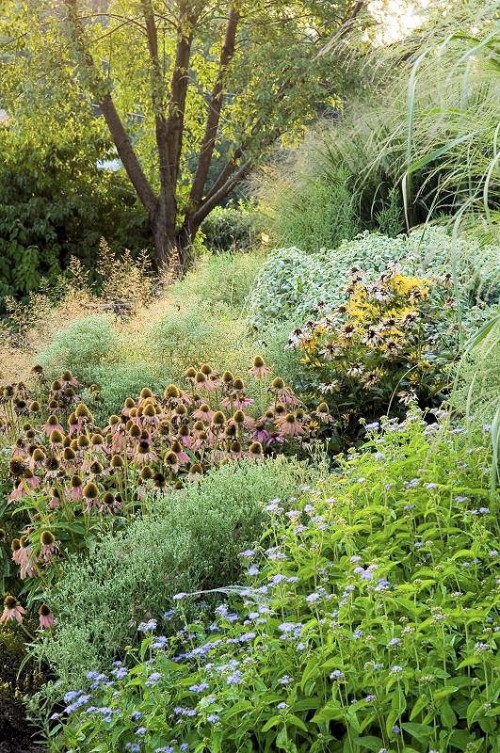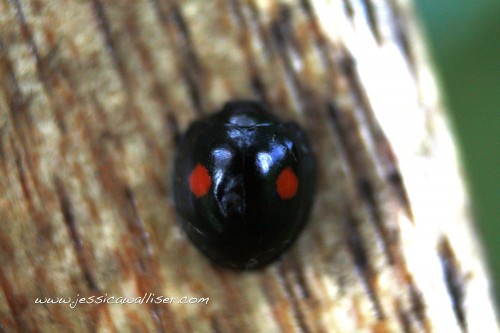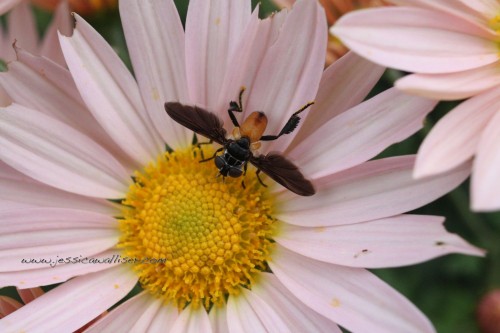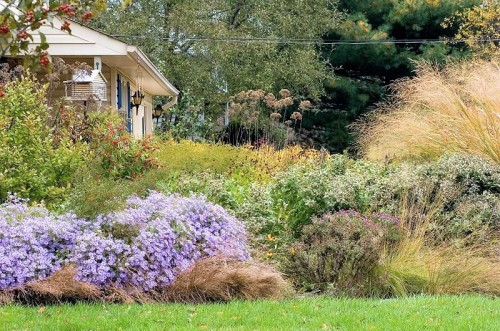Interview with Jessica Walliser, Author of Attracting Beneficial Bugs to Your Garden
Jessica Walliser’s new book,Attracting Beneficial Bugs to Your Garden: A Natural Approach to Pest Controlrecently published by Timber Press, turns the gardener’s view of insects upside down. Suddenly, they are no longer the enemy, but allies you encourage by the way that you garden. Jessica and I had a lively email “chat” that I hope will give you an insight into what her book is all about.
Who’s Afraid of the Big Bad Bug?
Kathy: Jessica, I really appreciated your introduction. Confessing that you used to be a bug hater and used to spray a lot—I think many gardeners could confess to the same thing. But perhaps not as many have made the connection that nurturing insects is an essential part of organic gardening. As you say, “Now I know that a beautiful garden lives in harmony with billions of insects. I choose plants for them; I garden for them as much as I do for myself.” Was there an “aha!” moment that caused this shift in thinking for you, or was it a gradual realization? Can you remember the first plant you bought specifically for the insects?
Jessica: My “aha!” moment came when watching the BBC documentary “Life in the Undergrowth,” as I describe at the start of Chapter 1. That slug sex scene stirred something in me (not that kind of stirring…). It really spoke to the fact that even though I had been a professional gardener and organic farmer for many years, I never really paid much attention to the minuscule, yet utterly amazing, acts of nature happening all around me every time I stepped outside. I was always so focused on plants that the insect world never really entered my field of vision except in terms of “saving my plants” from them. That all changed when I started paying attention and really, truly seeking out insects and learning about what they do.
Though I had been growing many insect-friendly plants for years without really knowing their importance to beneficials, the first intentional insectary plant I purchased was meadowsweet (Spirea alba). For the life of me, I can’t understand why more people in USDA zones 3-7 aren’t growing this plant, except for perhaps availability issues. It is so beautiful, and it is absolutely swimming with pollinators and beneficial insects the moment it comes into bloom. The second plant I intentionally planted was Virginia mountain mint (Pycnanthemum virginianum).
Taking Baby Steps
Kathy: If a gardener is not prepared to “garden for the insects,” are there one or two plants that appeal to a wide range of beneficials that a gardener who’s just starting out down this path could plant? You know, if they just want to take a baby step or two towards this goal?
Jessica: One of the most important things to remember is that no one has to “prepare” to “garden for the insects”; anyone who grows flowers is already gardening for them–even though they may not know it. Just the fact that they have a garden (instead of a lawn!) is good for beneficial insects. There’s an enormous issue with disappearing bug-habitat in this country and even the smallest flower garden is capable of supporting thousands of insects.
This is not to say that all gardens are equally as good, because that certainly isn’t the case. But every garden helps. For most gardeners, a small switch in our thinking is all that’s really needed to start providing for beneficial insects. Not only does a garden have to provide habitat, it also has to provide the right kind of pollen and nectar sources (not just any flower will do). So, in cases where there is already an existing garden, we can pump-up the amount of available resources by adding the right plants to the existing mix.
Thankfully, there are so many common plants capable of providing nectar, pollen, and habitat for beneficials. As long as you are not regularly blanketing your garden with pesticides, you may already have the start of a good insectary border. Black-eyed Susans, cosmos, sweet alyssum, yarrow, sunflowers, dill–most gardeners probably already grow some of these. They are a good place to start.

You may already have good insect plants, such as black-eyed Susans and coneflowers, already growing in your garden. Photo (c) Rob Cardillo and used with permission.
Ladybug, Ladybug, Where Art Thou?
Kathy: I was surprised to learn that the Nine-Spotted Ladybug is New York’s state insect, and saddened to learn that it hadn’t been seen for over twenty years, until spotted once again in 2006 by children in Virginia, and in 2011 on an organic farm in NY. I used to enjoy those ladybugs as a kid. Can you tell us more about the Ladybug Project? Is there anything else we can do to help these ladybugs?
Jessica: The Lost Ladybug Project is an amazing testament to the reach of citizen science. It was started by Dr. John Losey at Cornell University in 2000 and has since become the largest and most geographically widespread ladybug database in existence. Because of it, Dr. Losey’s team has confirmed the recent shift in ladybug populations across North America. When I interviewed Dr. Leslie Allee, their current director of education, her passion for the project was loud and clear.
Though there are many causes for the decline in many of our 480 native ladybug species, including pesticide exposure and habitat loss, researchers also suspect that the increase in non-native, uber-competitive ladybug species, like the multicolored Asian ladybug, is also to blame.
Studies conducted by Dr. Losey and his team confirmed that introduced ladybug species are quicker to reproduce and eat more than native species. One study that paired native ladybugs with introduced species, both with and without alternate prey, determined that in both cases the introduced ladybug species always consumed the native.
In my own garden, I’ve watched multicolored Asian ladybugs eating native ladybug larvae on many occasions. They’re simply more aggressive than many of our natives. The Lost Ladybug Project asks gardeners, 4-H groups, schools, Master Gardeners and other organizations and individuals to take photos of any and every ladybug they find and upload them to their website (www.lostladybug.org). It is amazing how many different ladybug species you can find in your own backyard! Two summers ago, after spending just a few minutes looking every day for one week, I found eight different species in my own small garden, all of which are pictured in my new book.

One of the ladybugs Jessica found in her garden, the twice-stabbed ladybug (Chilocorus stigma) eats bad bugs while in the larval stage and the adult stage, but it needs pollen and nectar to survive. Photo courtesy Jessica Walliser.
We can help foster our native ladybug species by eliminating pesticides (even organic ones which can smother soft-skinned ladybug eggs and larvae), learning to recognize their larvae (they look a bit like miniature alligators), planting nectar sources (such as anise, baccharis, boltonia, boneset, coriander, daisies, dill, goldenrod, meadowsweet, angelica, and lovage), and allowing our garden plants to stand through the winter. (They provide much needed overwintering sites for lots of beneficials.)
Out, Out, D-mned Pest!
Kathy: Three pests that plague the Northeast (where I live) are the Japanese beetle, the scarlet lily leaf beetle, and the viburnum leaf beetle. What beneficial insects reduce their numbers, and what plants nurture the beneficials?
Jessica: Ahhh…herein lies one of the biggest problems human society is ever going to face (and you thought global climate change was bad…). Did you notice that all three of the pests you named are exotic introductions? The first hails from Asia while the other two are European imports. None of them are native to North America…in fact, most of agriculture’s biggest pest issues are the result of non-native insects. These insects do not belong here and because of that, the natural system of checks-and-balances they co-evolved with isn’t here either.
Every insect co-evolved with scores of specialized predators, parasites, and parasitoids meant to keep their populations in check. When insects are moved to a different part of the world, the predators and parasites do not come along for the ride. So, they get here, and nobody recognizes them as a food source. No birds, no predatory bugs, no parasitic insects, nobody. They are completely foreign, and without anybody keeping them in check, their population grows uninhibited.
USDA researcher Joseph Patt works on the issue of introduced pests every day and in an interview for the book, he noted that it can take many, many generations for a predatory insect to see these foreign insects as food. They are unfamiliar with their taste, smell, and activities. It is possible for a predatory insect to eventually take interest in an exotic pest as a food source, but first the predator or parasitoid has to mutate a number of times over several generations. Think about brown marmorated stink bugs. They’ve been here since the late 1990’s and we are just now starting to see generalist predators like praying mantids, assassin bugs, and birds eating them.

Tachinid flies, such as the Trichopoda pennipes pictured here, have learned to lay their eggs in Japanese beetles. If you have problems with Japanese beetles, you’ll want to grow flowers that help tachinid flies survive. Photo courtesy Jessica Walliser
Japanese beetles have been in North America for a lot longer than that, so they are preyed upon by generalist predators more frequently, and some species of tachinid flies are now using them as hosts for their young. Planting members of the daisy and brassica family are good nectar sources for tachinid flies.
Less Buggy Fruit?
Kathy: What about fruit trees? Does growing a garden of plants that nurture beneficial insects help combat insect damage? I’ve often thought about growing apples—they grow wild here—but I don’t want to spray. One alternative is to eat buggy apples, right? But can you eliminate the problem by growing plants that benefit the beneficials?
Jessica: The problem won’t ever be eliminated (nor should you want it to be, because in order to have a healthy population of “good bugs” you need to have some “bad bugs” for them to eat!), but it can be kept at minimal levels. I read hundreds of studies while researching this book, and hands-down, the biggest take-home point from all of them is that increasing plant diversity leads to an increase in beneficial insect populations and an increase in the number of pests consumed.
One study described “spectacular parasitism rates” in an apple orchard that was interplanted with a blend of flowering plants. Another found that parasitism of tent caterpillars and codling moths was eighteen times higher in orchards with flowering undergrowth than in those with just grass or mulch.
Sunflowers are another awesome addition to the orchard. Because they produce EFN (extra-floral nectar, which is nectar produced from structures other than flowers–in the case of sunflowers, it is produced on their leaf undersides), they start attracting beneficial insects when they are just a few inches tall. Plant rows of sunflowers between orchard rows or in groupings around individual trees.

A garden can look spectacular while many beneficial insects are eating or parasitizing the harmful ones. Photo (c) Rob Cardillo and used with permission.
It Takes A Fortnight
Kathy: When you saw your beloved tulip poplar tree attacked by “hundreds and hundreds of aphids,” you panicked. But then you got a grip and decided to “give the good guys some time to do their stuff.” In a week and a half you saw ladybugs arrive to eat the aphids, and seventeen days after you noticed the aphids, both the aphids and the ladybugs were gone. This makes me wonder how often we miss the whole bug-eat-bug cycle. I also wonder if there is a typical wait-and-see period–is waiting two weeks kind of standard?
Jessica: We miss it all the time! It is happening every single day of the growing season, without fail. Day AND night. Now that I know what to look for, I could take a walk through your garden on any given day and note dozens of bug-eat-bug interactions that would otherwise go unnoticed.
Gardeners need to learn what to look for in terms of both identifying the beneficials and identifying evidence of their work, only then is it possible to see all the amazing intricacies of the predator and prey cycle (or the bug-eat-bug cycle, as you call it). One of the main goals of this book is to teach gardeners what all of this looks like and how to discover it in their own garden and let the good bugs do their work unimpeded.
When I lecture to groups about this topic, I ask them to promise to give the beneficial insects two weeks to do their work whenever a pest infestation is noted, especially if the pest is a native species. Learn what to look for and you’ll see some truly amazing stuff.
Was This Winter A Killer?
Kathy: I’ve seen a few stories postulating that this cold winter may kill a lot of insect pests. But won’t it also kill the beneficial insects as well? Do you think it will actually make a difference in insect damage? Or will we just see less insects across the board?
Jessica: There are so many factors that influence the winter survival rate of all insects. Humidity levels, temperatures, exposure to wind and sun, state of diapause (bug hibernation), sheltering site, the overall fitness of a particular insect, and many other variables are involved. Most insects have a degree threshold down to which they will survive, but the survival rates are also tied to the other factors I listed, as well as to the amount of time the temperature was sustained. By looking at previous survival rates as they relate to weather patterns, scientists can guess how things will go, but only nature knows for sure. It will be an interesting gardening season for sure!
Now What?
Kathy: Are you aware of Gail Eichelberger’s blog Clay and Limestone? She is an enthusiastic advocate for nurturing pollinators and for eschewing all pesticides. Can you suggest other online resources?
Jessica: I encourage all gardeners to get involved in citizen science projects whenever possible. The collective power of gardeners as a whole is pretty incredible. Together we can make an enormous difference in the ability of researchers to preserve and interpret data regarding changes in plants and insects due to climate change and foreign plant and insect introductions. The Lost Ladybug Project is a good place to start, as are organizations like The U.S.A. National Phenology Network, the Leopold Phenology Project and Project BudBurst. These organizations invite gardeners across North America to join them in collecting data on natural observations–everything from when a lilac comes into bloom and the date of the first Japanese beetle appearance, to a songbird’s arrival and the sighting of a monarch. It is one way we can make a difference.
Kathy: Anything you want to include that I didn’t ask about?
I could talk all day about how amazing bugs are…but instead, I’ll leave your readers with my website, www.jessicawalliser.com, and my brand new blog, Savvy Gardening, where they can learn more about insects in my posts to The Bug Chronicles.
You Might Also Like
Mike Cherim of Green Methods: Ensuring that good bugs rule!
Jessica Walliser: Organic Gardening Advocate
Grow Organic: Book Review
Three Gardening Books For Children






Great article, I wish more people could see the beauty of bugs, rather than just have the ick factor.
Are you aware of any websites for identifying bugs? I often see new beauties in the garden, but have no way to id them. Where to start?
Gardenweb has a forum called “name that plant” and you post a photo and within hours you will have an id. Would love to find something similar for insects.
Brenda, see if Bug Guide helps you.
Kathy this is great info and advice…much to take in and ponder. Thanks.
Excellent interview and now I must have this book! gail
I always love a good read about anything garden-related. This book sounds fantastic – good for the bugs, for the garden and for my education. Thanks for the interview!
Great interview Kathy. It sounds like a good book. Thank you. I tweeted it. 🙂
I can’t wait to visit this website and blog. I love all insects and am fascinated by them! I keep a running list of insects I can positively ID on my blog (along with my bird sightings). It always makes me excited when I see a new insect in my garden. It makes me feel I am doing something right. The more insects – the more birds and so on. Now I can’t wait for Spring – okay, I couldn’t wait before, either – to be out in my garden and see what I can find!
Thanks, Kath, that was really interesting and helpful. Good to know I have a rationalization for overpurchasing seeds of plants from the Brassica family!